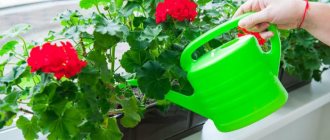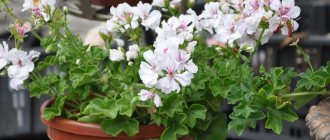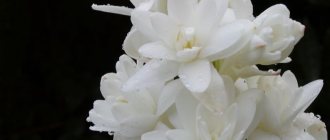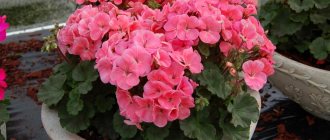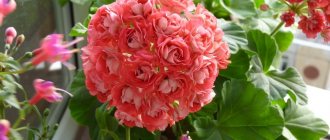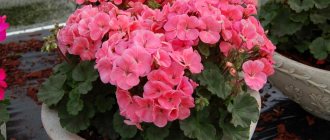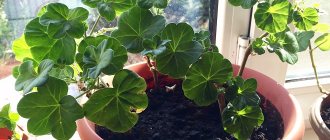Geranium is a favorite of many gardeners who prefer houseplants, due to its unpretentiousness not only in the conditions of its maintenance, but also in its methods of propagation.
One of the simplest is the cutting method. In the article we will look at how to grow geranium from cuttings at home, methods of rooting cuttings and when it can be transplanted into a pot.
Is it possible to plant like this?
Due to the ability of geranium to survive and continue to grow even in unfavorable conditions, it can be propagated without the use of roots. But in general there are three ways to propagate this crop:
The first method takes too much time and patience, because in order to germinate the seeds, you need to provide strictly defined conditions, the second is quite risky, since the delicate roots are very easy to damage during their division, but the third, by cuttings, is preferred by most people involved in growing and breeding geraniums.
The main advantage of this method is the ability to propagate a plant without disturbing its roots, which guarantees the complete safety of the mother plant.
What is a cutting, how to choose and prepare it correctly?
A shoot, or cutting, is a cut part of a plant with one or more nodes.
This cut off part is precisely used for vegetative propagation (by cuttings). In order to get a new geranium, completely identical to the previous one, you first need to select this cutting. When should you take a cutting from the mother flower in order to plant and grow a young plant? The mother plant should be well developed and absolutely healthy, ideally it should be 2 - 3 years old. You need to select the apical cuttings of the mother geranium. This process should be 7–8 cm in length, have one or more nodes (buds, growth points) and 3–5 leaves. If there are leaves left at the base of the cutting, they must be carefully removed.
If the branches of the shoot are the same length as the shoot itself, then you definitely need to cut them off, and then you can use them as independent cuttings. And the finished shoots are left in the air so that the cut areas dry out. If after a few hours they are covered with a thin film, it means that everything went well and the cuttings are ready for the next stage.
Methods for propagating geraniums
There are several ways to propagate the plant. The most common: seeds and cuttings. To choose the best option, it is worth considering each in detail.
What does indoor geranium look like?
Vegetative (from shoots or cuttings)
In most cases, flower growers propagate pelargonium by cuttings, since the seed material cannot always convey the parental qualities of the flower. To root geranium vegetatively? Cuttings from the top of the shoots or the middle shoots remaining after pruning are suitable. For propagation, experts recommend containers for seedlings or ordinary plastic cups.
It is important to know! The planting container must have drainage holes.
Universal soil, diluted with river sand, is excellent for germination. For disinfection, change a weak solution of manganese, or pre-calcinate the soil.
Generative (seeds)
The process of propagation by seeds is extremely labor-intensive. Before the procedure, it is important to decide how to plant geraniums using this method. First of all, pay attention to the quality of planting material. It is advisable to purchase seed material in specialized stores.
How to carry out the procedure?
The cut shoots do not yet have roots, which are necessary for the development of full-fledged geraniums, so after their preparation it is necessary to root the cuttings. This can be done in water or directly in the prepared substrate.
Rooting cuttings in water
How to propagate a plant by placing cuttings in water? The main advantage of this method is the ability to observe the process from beginning to end and not miss the moment when the shoot has roots and can already be planted in the substrate.
Prepare a small transparent container (disposable cups work great).- Pour settled water at room temperature into a container up to about half a glass (5 cm).
- Place the shoots in water.
- Change the water once every 2 days.
- After about a week (during this period the first roots should appear), transplant the rooted cuttings into the prepared substrate in a container of a suitable size.
Rooting in water also has its significant disadvantage: sometimes the cutting can rot before it even takes root, and in order to prevent this, gardeners strongly recommend adding crushed activated carbon to it for disinfection every time you change the water.
Using this method, you can get beautiful and healthy geraniums.
Rooting in the ground
Is it possible to plant a cutting without roots directly into the ground? Thanks to rooting in the ground, you don’t have to worry about the shoots rotting, since this happens extremely rarely, but you won’t be able to see when the roots will appear, which is why the planting material sometimes gets spoiled by being replanted ahead of time. How to plant correctly can be read in the instructions:
Prepare a substrate from garden soil and peat.- Place the prepared soil in a small container, moisten it generously and compact well.
- Choose a place with sufficient diffuse lighting. Cuttings really do not like scorching rays.
- Place the shoot into the substrate to a depth of 4–5 cm and again compact the soil around it.
- Waiting for new leaves to appear on the cuttings means that it has successfully taken root and is ready to be transplanted into a full-fledged pot. This will take about a month.
Other ways to plant geraniums
Royal geranium - home care for beginners
Other methods of reproduction are used extremely rarely. Growing from seeds is a troublesome task, and dividing the root can only be done during transplantation. In some cases, these methods are still resorted to.
Seeds
It is best to grow the seed in pre-prepared soil. The planting container is filled with nutritious soil and potassium permanganate. Sowing is carried out superficially. It is extremely important to create the right microclimate for growing. Conditions should be close to greenhouse conditions. To do this, take a container with a lid.
Dividing the root system
Additional Information! It is important to provide fresh air to the seeds. Otherwise they will begin to rot.
Transplantation is performed after the first leaves appear. It is not easy to grow a healthy plant from seeds at home. When the pelargonium has 3-4 full leaves, it is transplanted into a new container.
By dividing the rhizome
During transplantation, it is convenient to use the method of dividing the bush. The best time for propagation using this method is autumn. The flower is completely removed from the pot and divided into several parts as carefully as possible. Sanitary pruning is done not only for branches, but also for damaged or diseased root processes.
Plant care should be regular
Transplanting into a pot: when and how?
A cutting that is placed in the ground produces roots only after a month, but unlike the method with water, the roots will not rot, so the likelihood of getting a new plant is very high.
- Remove the cuttings that have taken root from water or soil.
- Prepare the substrate: 2 parts turf soil, 1 part sand, 1 part humus, 1 part leaf.
- Choose the right size container: shallow and quite wide, because geraniums have a shallow root system.
- Place good drainage at the bottom of the pot.
- Place soil in a container and moisten it.
- Plant the sprout in the substrate and compact the soil around it a little.
- Place the pot with the plant on a well-lit windowsill.
A cutting rooted in water is replanted after a week, and one rooted in the ground after a month.
The dates presented above are approximate , so first of all you need to look at how the process develops.
Pruning and pinching geraniums for dense shoots and lush flowering
How to pinch geraniums for lush flowering photo
In order for the plant to look neat on a windowsill or flower bed, it must be trimmed. To do this, choose the period of late winter or early spring, when flowering stops. Old shoots and leaves are trimmed, providing a neat appearance to the bush.
To branch and form several shoots, pinch the bush after 8-10 leaves . This is how the lateral shoots will go, which also bear peduncles. The procedure is not painless for the plant, so it is important to apply fertilizer a couple of days before pruning, and water 1-2 times a week, as needed. Flowering may shift, but not by more than a month. During this time, new leaves and stems will grow.
This video will tell you about pinching geraniums:
New shoots and stepchildren may form in the axils of the leaves, which need to be removed when there are 1-2 leaves. Otherwise, the bush will take on an irregular shape, and additional shoots will add disharmony to the overall composition. Only shoots from the root are left.
Pruning geraniums in winter on video:
Be sure to remove faded inflorescences from the bush so that the plant’s strength is not taken away and new flower stalks can form. If dried flowers are left, the plant will begin to form seeds and stop blooming.
How to prune geraniums in spring, watch the video:
Having shown the necessary attention, the gardener will always promote lush flowering of geraniums, beautiful growth of green mass, and healthy appearance of plants.
When can a flower be propagated in this way?
Geraniums can be propagated by cuttings all year round, but flower growers are of the opinion that during the dormant period (mid-autumn - end of winter) it is better not to touch the plant, because at this time it is very vulnerable, and therefore the mother geranium may die. Therefore, the most optimal period is spring, when geraniums begin their growing season and are still full of previously accumulated strength.
Propagation of a plant such as geranium is a fairly simple process that anyone who takes it upon can do it. And proper and timely care for a rooted plant will help it delight the eye with its attractive and aesthetic appearance.
If you find an error, please select a piece of text and press Ctrl+Enter.
Geranium is a well-known plant that almost all gardeners know and grow without problems. Or at least have experience in growing this unpretentious flower.
He loves rare, but at the same time abundant watering, he is not afraid of open air. Geranium is more associated with our grandmothers, but no one forbids those who are much younger from growing it. How to properly plant geraniums with shoots, including without roots, read on. Also watch a useful and interesting video on the topic.
Caring for young geraniums
Figs - growing at home, how to plant
Geranium is considered an unpretentious plant. The duration and abundance of flowering ensured its great popularity. Many varieties have a refined aroma. Even a novice gardener can cope with the care and cultivation of the crop. The health and visual attractiveness of the plant depend on the efforts of the grower. With proper maintenance, the crop retains its decorative properties, and its lifespan is at least 10 years.
Comfortable conditions for growing geraniums:
- loose soil;
- good lighting;
- comfortable air temperature (about 25 °C in summer, not higher than 16 °C in winter).
Spraying a flower
Spraying has a beneficial effect on the condition of geraniums. For the procedure, filtered and settled water is used. Watering is carried out regularly. In summer, moistening is carried out at the first signs of drying out of the soil.
To ensure full color, the plant must be fertilized every 2 months. It is best to choose complexes containing nitrogen. You should also prune regularly. In its absence, the bush becomes shapeless and loses its attractiveness.
Based on all of the above, the conclusion suggests itself that geranium is a useful and easy-to-care plant. Every flower lover should have one, having carefully studied the issue of planting a flower.
Landing Features
When to plant or transplant this flower? You should be guided by two criteria:
Appearance of the plant : if the flower grows very slowly, but is properly cared for, then this most likely means that it is time to plant it in another, larger pot.- Soil inside the pot : if after watering, the soil dries out quickly enough, this means that the roots of the flower have grown, and it’s time to change the pot to a larger one.
There is also a universal method that will help determine whether it is time for a transplant or not. You need to remove the plant from the pot and carefully examine the lump of earth. If the roots literally penetrate right through the ground and there are a lot of them, then it’s time to replant the plant.
Watch a video about transplanting geraniums:
General Tips
- Ideally, it is better to replant geraniums in the spring . It is necessary to prepare in advance a larger pot into which the flower will “move”.
- It is not necessary to replant the geranium into a new pot, but it must be disinfected . Also, to transplant geraniums you will need a watering can with water and fresh soil.
- It is not advisable to replant geraniums during flowering, but it is possible . If possible, it is better to avoid this.
- To remove geraniums from an old pot, you must first water it . And then you need to hold the pot with one hand, and carefully pull the flower with the other. As a last resort, there is an option to use a knife. With its help, you need to very carefully separate the soil from the walls of the pot.
Caring for geranium is not so difficult, you just need to know what this flower loves:
- Sunlight (but light shadow is also not a problem for it), it tolerates exposure to southern and eastern windows especially well.
- Warm weather (but nothing will happen to the flower even with slight autumn frosts).
- Watering: infrequent, but plentiful.
- The pot must have good drainage.
- Interestingly, the soil should be moderately fertile, even poor. In other cases there will be few flowers, but a lot of greenery.
- In order for geraniums to continue to bloom, it is important to remove those inflorescences that have already faded.
- It is important to regularly feed the soil; you need to start fertilizing in the spring, and continue until the fall once every 2 weeks.
Growing conditions in open ground (outdoors)
With proper care, a flower can grow in open ground, the main thing is to follow the following rules:
- Priming. To plant geraniums outdoors, choose a light soil with an acidic or neutral reaction. Its composition necessarily includes peat, river sand and humus. They have a beneficial effect on plant development.
- Illumination. The flower loves good lighting, so it is ideal to place it in sunny areas. But even in partial shade, geranium can actively develop and bloom profusely.
- Temperature conditions. To grow a plant outdoors, a temperature of at least 11–13 degrees is required. Otherwise, the leaves will begin to fall off, and the flower may soon die.
- Air humidity. Geranium does not require special conditions. Tolerates wet or dry weather well. The only thing is that it cannot be sprayed, this can lead to burns on the leaves.
- Watering. The plant needs regular watering, but do not allow standing water, as root rot may occur. Geranium also does not respond well to drought; it stops blooming or the leaves begin to turn yellow. But after adding water, all elements of the plant are restored. Therefore, it is best to water after the top layer of soil has dried.
- Fertilizers. In order for the plant to be thick and lush before flowering, fertilizers with a high phosphorus content are applied. During the formation of inflorescences and during the active flowering phase, potassium fertilizers are used once every 2 weeks. Organic fertilizers are not applied; geranium reacts poorly to them.
- Transfer. Replanting an outdoor plant is carried out until the thermometer drops below 10–12 degrees. Most often this happens in mid-September. Before the procedure, the flower is prepared. Remove dry leaves and stalks.
The pot is chosen to be wide, so that the root system is free, but not too large, otherwise the geranium will stop blooming.- On the eve of transplantation, the plant is watered abundantly.
- They dig it up together with a lump of earth.
- A drainage layer must be placed at the bottom of the container.
- If the bush has grown greatly, then it is divided into several parts and planted in different flowerpots.
- The upper roots of the flower are deepened, and the empty spaces are filled with earth, but not compacted.
- Afterwards the geranium is watered abundantly.
What do you need to know before propagating a flower?
How to propagate? There are several ways to propagate geraniums . But the best way is to use cuttings or shoots.
Why exactly is this method better? One of the advantages is that with this choice you can see which geraniums are grown using this method - it is clear what will grow in the future. That is, the growth of the plant, what color the flowers and leaves will be. When is the best time to take cuttings? It is possible all year round, best in July-August and February-March.
When should I take a cutting from geranium flowers to plant? Before taking a shoot, you need to follow a number of simple rules :
You need to choose a well-developed specimen of the flower as the mother plant; in order for rooting to take place, you need to cut off the apical shoot, which has a well-developed growing point. The length of the cutting should be about 7 cm. Such a cutting should have about 4 leaves. The bottom two must be torn off.- Then you need to put the cutting in water so that roots form. This usually takes 2-3 weeks.
- Is it possible to plant a cutting without roots in the ground? Oddly enough, yes. But under special conditions. Many gardeners, having kept the shoots in the shade for about a day, and having previously dipped them in crushed coal, need to plant them in a light mixture at a temperature of +20...+22°C. You need to wait about a month for rooting in this way.
- It is important to compact the soil around the seedling well and always in a generous manner.
- It is important that the shoot is provided with good lighting at room temperature.
- How do you know if the cuttings have taken root? If they have formed new leaves, this means that their horse system is developed and there is no need to wait any longer. You can transplant the plant into a permanent pot.
Find out more details on how to transplant geraniums into another pot and grow them from cuttings here.
Main difficulties in reproduction
If the plant is kept in a too hot room at 26°C or more, or, conversely, in a cold room where the temperature is below 16 degrees, it will be difficult to get roots.
If there is often a draft in the room and the temperature changes, it is better to cover the container with film, which will remain until the root system appears. It needs to be removed daily for ventilation.
The same requirements apply to seed propagation. If you do not follow the rules and do not maintain the necessary conditions, the seeds are unlikely to hatch.
It is important to observe the light regime when the seedlings are already on the windowsill. To ensure that all seedlings receive the same amount of light, the container must be turned regularly.
As a result, you need to choose the right cutting; it must be cut from a young shoot. The old branch will not be able to give a positive result when propagated.
How to plant correctly in a pot with soil?
How to plant correctly? First you need to properly prepare for this. To do this, you need to follow the following instructions:
- Sharpen the knife as sharp as possible.
- Carry out thorough disinfection with medical alcohol.
- Cut the cuttings as carefully as possible. Definitely from the top with 3-4 leaves. But under no circumstances with buds! Otherwise, roots will not grow on such shoots for very long.
- Place the resulting raw material in the shade for a while. Which one? When a new film appears at the cut site.
- Sprinkle the cut with Kornevin; if desired, you can use coal dust instead.
Watch a video about propagating geraniums by cuttings without roots:
Further care
You need to specially prepare the cups - make holes in them for water drainage . In addition, thanks to the holes, air penetrates to the roots, which is also very good.
Next you need to follow the following instructions:
Add a little vermiculite to slightly wet, damp soil.- Fill each cup with soil,
- If the soil was treated with boiling water, you must, of course, wait until it cools down. Fortunately, this will not take much time. Only a few minutes.
- Place the shoots that were previously freed from the lower leaves and deepen them a few centimeters.
- Leave the glasses on a tray (to make them convenient to move) and place them in a dark place for a while,
- After 5 days, the cups need to be moved to the window. Preferably NOT on the south side.
What to do if yellow, limp leaves appear on some plants? You can place them under the jars. That is, create something like mini-greenhouses for them. Thanks to the special microclimate, the plants will recover in a couple of days .
How to cut and prepare a shoot
Pelargonium can be grown at home for up to 10 years, but most often its trunk is bare, leaves grow only on the tops of the branches. This is why gardeners prefer to rejuvenate plants after a few years. With shoots and cuttings you can grow from 5 to 10 new plants from one mother plant, knowing how to cut and root them.
Is it possible to do this all year round? Yes, but the percentage of rooted cuttings is much higher in spring and summer. If the mother plant is at rest, then rooting will occur very slowly, and the geranium shoot may rot. The process occurs much faster at the beginning of the growing season, that is, the best time is from March to May and from July to early September, when geraniums no longer bloom.
How to grow geranium from seeds
Growing geraniums from seeds photo seedlings
- Seeds are sown in bulk on the nutrient mixture as little as possible, sprinkled with a thin layer of earth or sand on top.
- Pots for seedlings are chosen small in size, 50-100 ml.
- After planting, the container is covered with film to create a greenhouse effect that helps the seeds germinate as quickly as possible.
- Every day it is necessary to remove accumulated condensation from the film so as not to provoke the development of fungal diseases.
- When the first shoots appear, the film is removed.
- Watering is carried out as needed, without waterlogging the soil.
- After 2-3 true leaves appear, the bushes are planted in containers for continuous growth.
- Seedlings must receive a lot of light so that development occurs fully, the plants do not stretch out and do not get sick.
The video will tell you more about growing geraniums from seeds:
It’s not a difficult task, so even novice flower growers and schoolchildren can handle it. By the way, children really like to participate in the process of growing seedlings. Then they watch with delight as the plants develop, release their first buds and delight with abundant flowering.
Methods for rooting a shoot
Roots can form in water or soil; the choice of method depends on the type of plant, time of year and the desires of the grower. If we let the cutting sit in water for too long, it may rot. For example, royal geraniums form roots in 35–40 days, which means this method is not suitable for them.
In water
The cuttings are placed with a dried cut in water (at a level of 4 cm). It is better to take an opaque container and disinfect it before use. The water should be soft, clean, settled, at room temperature (+22...+24 °C), it should be changed after 1–2 days. Some gardeners argue that you cannot change the water when rooting cuttings - they say, it’s better to just top it up. To reduce the risk of stem rotting, you can add crushed activated carbon.
The dishes with the appendage are placed in a lighted place, avoiding direct sunlight. Daylight should last at least 16 hours, and at night the temperature should not drop sharply. With this method, it is convenient to observe the growing roots, and you can easily determine the moment of planting in the ground.
In the ground
If you know how to plant a varietal geranium with a shoot without roots directly in a pot with soil, you can quickly wait for a new plant. Planting of prepared geranium shoots should be carried out in nutritious, loose, slightly acidic soil to a depth of 1.5–2 cm. Experienced gardeners make a soil mixture of drainage soil, peat and sand, sometimes adding vermiculite. A layer of expanded clay is poured into a pot with drainage holes, then soil, and a small layer of sand is added on top, which provides some protection from waterlogging of the base of the cutting.
The soil must undergo a disinfection procedure. To do this, it is heated in the oven for 20–30 minutes or poured with a hot solution of potassium permanganate. The pot must also be disinfected before use. It is recommended to use formalin or just boiling water. Make a hole in the middle with a pencil, place the cutting, and press the soil tightly against it.
It is not recommended to cover cuttings planted in this way with a jar or plastic wrap, but this can be done if the leaves begin to dry out along the outer edge. After the leaves are restored, the jar is removed. The dishes with the shoots are placed in a bright, warm place - it can be a window sill, but without the drying effect of the central heating radiator and without direct sunlight. Water them moderately after the top layer has dried. For watering, use clean water at room temperature and a watering can with a narrow spout, directing the water to the ground so that it does not fall on the leaves and stem. Overwatering threatens the appearance of blackleg, which means the loss of the plant.
The appearance of new leaves signals that the plants have taken root. This may happen after a week or even after 3 weeks. From this moment they can be transplanted to a permanent place of growth.
Further care
Knowing how to plant geraniums without roots, gardeners often propagate varietal plants purchased at a high price. Plants rooted in water or soil are planted in pots or boxes with a mandatory drainage layer and nutritious loose soil. Caring for them includes creating comfortable conditions with the necessary amount of light, suitable air temperature, sufficient watering and regular feeding.
So, at home, young plants are most often placed on window sills. They can also be used to decorate balconies, galleries, and be planted in flower beds in the summer. The main thing is to provide the plants with at least 16 hours of daylight and protect them from direct sunlight, even when planted outside.
Geranium does not like moisture on its leaves; it must be protected from this by spraying neighboring plants, and it must be watered so that the stream of water is directed towards the walls of the pot. Young, recently rooted plants are often watered using the bottom method - placing them in a pan of water for 0.5 hours.
It is important to monitor the looseness of the soil, because the roots of pelargonium love to receive fresh air constantly. Fertilizing is carried out with special complexes of mineral fertilizers (for example, “Pelargovit”) no more than every 2–3 weeks, simultaneously with watering.
In order for plants to form lush bushes, they need to be carefully pinched with clean hands or disinfected scissors, treating the cut areas with activated carbon.
Planting rooted cuttings
Prepare pots for replanting. Remember that geraniums do not like large containers. Make drainage, fill the soil. Make a hole in the middle of the pot and insert the rooted planting material into it. Firm the soil around the stem.
What should the soil consist of? Peat and sand are required. The main quality of soil for geraniums is looseness. At any flower shop you can purchase special soil for pelargonium. After planting, water the plant and place it on the windowsill. If the first leaf appears, it means the plant has taken root.


